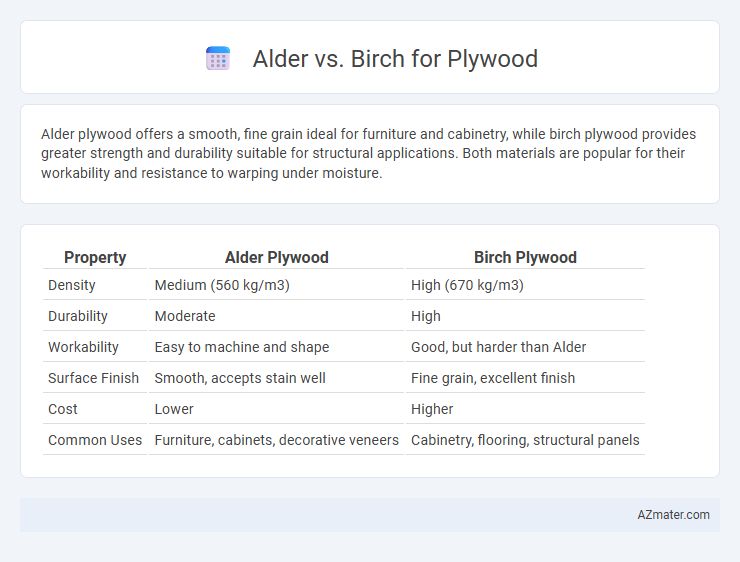Alder plywood offers a smooth, fine grain ideal for furniture and cabinetry, while birch plywood provides greater strength and durability suitable for structural applications. Both materials are popular for their workability and resistance to warping under moisture.
Table of Comparison
| Property | Alder Plywood | Birch Plywood |
|---|---|---|
| Density | Medium (560 kg/m3) | High (670 kg/m3) |
| Durability | Moderate | High |
| Workability | Easy to machine and shape | Good, but harder than Alder |
| Surface Finish | Smooth, accepts stain well | Fine grain, excellent finish |
| Cost | Lower | Higher |
| Common Uses | Furniture, cabinets, decorative veneers | Cabinetry, flooring, structural panels |
Alder vs Birch for Plywood: An Overview
Alder and birch plywood differ significantly in grain pattern, durability, and cost. Alder plywood features a fine, consistent grain with a warm, reddish-brown hue, ideal for furniture and cabinetry requiring smooth finishes, while birch plywood is known for its light color and strong, resilient construction suited for structural applications. Birch typically offers higher strength-to-weight ratio and greater resistance to warping compared to alder, making it a preferred choice for demanding plywood projects.
Botanical Origins of Alder and Birch
Alder plywood derives from trees in the Alnus genus, predominantly found in the temperate regions of the Northern Hemisphere, known for its fast growth and lightweight wood. Birch plywood comes from the Betula genus, widespread across the Northern Hemisphere, especially in cooler climates, and is prized for its strength and fine grain. Both species belong to the broadleaf category but vary in regional distribution and wood characteristics, affecting their suitability for different plywood applications.
Appearance and Grain Differences
Alder plywood features a fine, straight grain with a light brown to reddish hue, creating a smooth and consistent appearance ideal for furniture and cabinetry. Birch plywood exhibits a tight, uniform grain with a pale cream to yellowish tone, offering a clean and bright surface favored in modern design applications. The grain pattern in alder tends to be softer and more muted, while birch presents a sharper, more pronounced texture that enhances visual depth.
Strength and Durability Comparison
Alder plywood offers moderate strength and durability, making it suitable for light to medium construction projects, while birch plywood is known for its superior strength and higher resistance to wear and impact, ideal for heavy-duty applications. Birch plywood generally exhibits a tighter grain and higher density, which enhances its structural stability and longevity compared to alder. When prioritizing strength and durability, birch plywood outperforms alder, making it the preferred choice for demanding environments and long-lasting usage.
Workability and Machining Properties
Alder plywood is known for its excellent workability, featuring a smooth surface that responds well to sanding, cutting, and shaping, making it ideal for intricate woodworking projects. Birch plywood offers superior machining properties due to its dense, fine-grained structure, which provides clean, precise cuts and minimal splintering during routing or drilling. Both species exhibit good dimensional stability, but birch's hardness makes it slightly more durable for heavy-duty machining tasks.
Cost and Availability of Alder vs Birch
Birch plywood is generally more expensive than alder plywood due to its higher demand and superior strength characteristics. Alder plywood tends to be more readily available and cost-effective, making it a popular choice for budget-sensitive woodworking projects. The cost difference and availability depend on regional supply chains, with birch often sourced from Northern Europe and alder primarily from the Pacific Northwest.
Environmental Impact and Sustainability
Alder plywood offers a lower environmental impact due to its fast growth rate and ability to regenerate quickly, making it a more sustainable choice compared to birch. Birch plywood, while durable and strong, often involves slower-growing trees, resulting in a higher carbon footprint and less sustainability. Choosing alder supports responsible forestry practices and reduces deforestation pressure, aligning better with eco-friendly construction goals.
Common Applications in Furniture and Cabinetry
Alder plywood is favored in furniture and cabinetry for its smooth texture and consistent grain, making it ideal for staining and fine finishes in high-end pieces. Birch plywood offers superior strength and durability, commonly used in structural components and modern cabinetry requiring a clean, light appearance. Both woods provide versatile solutions, with alder preferred for aesthetic appeal and birch excelling in load-bearing applications.
Finishing, Staining, and Painting Considerations
Alder plywood offers a smooth, consistent grain that absorbs stains evenly, making it ideal for achieving a rich, uniform finish, while birch plywood has a tighter grain pattern that can create a more varied staining effect, requiring careful sanding and pre-treatment for an even coat. When painting, alder's softer texture allows for easy application and good paint adhesion, whereas birch plywood, being harder and denser, may need a primer to prevent blotching and ensure a smooth painted surface. Both woods respond well to finishing, but alder is preferred for projects emphasizing stain finish, while birch is favored for its durability under painted applications.
Choosing the Right Wood for Your Plywood Project
Alder plywood offers a smooth texture and consistent grain, making it ideal for fine woodworking and furniture projects, while birch plywood provides superior strength and durability, suited for structural applications and cabinetry. Choosing between alder and birch plywood depends on the project's requirements for aesthetics versus load-bearing capacity, with alder favored for its workability and birch for its moisture resistance and stability. Consider the specific project environment and finish preferences to select the optimal plywood species for long-lasting results.

Infographic: Alder vs Birch for Plywood
 azmater.com
azmater.com